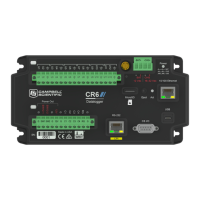9.10 Improving voltage measurement quality
The following topics discuss methods of generally improving voltage measurements:
9.10.1 Deciding between single-ended or differential measurements 147
9.10.2 Minimizing ground potential differences 148
9.10.3 Detecting open inputs 149
9.10.4 Minimizing power-related artifacts 150
9.10.5 Filtering to reduce measurement noise 152
9.10.6 Minimizing settling errors 153
9.10.7 Factors affecting accuracy 155
9.10.8 Minimizing offset voltages 156
Read More: Consult the following technical papers at www.campbellsci.com/app-notes for in-
depth treatments of several topics addressing voltage measurement quality:
l Preventing and Attacking Measurement Noise Problems
l Benefits of Input Reversal and Excitation Reversal for Voltage Measurements
l Voltage Accuracy, Self-Calibration, and Ratiometric Measurements
9.10.1 Deciding between single-ended or differential
measurements
Deciding whether a differential or single-ended measurement is appropriate is usually, by far, the
most important consideration when addressing voltage measurement quality. The decision
requires trade-offs of accuracy and precision, noise cancellation, measurement speed, available
measurement hardware, and fiscal constraints.
In broad terms, analog voltage is best measured differentially because these measurements
include the following noise reduction features that are not included in single-ended
measurements.
l Passive Noise Rejection
o
No voltage reference offset
o
Common-mode noise rejection, which filters capacitively coupled noise
l Active Noise Rejection
o
Input reversal
o
For more information, see Compensating for offset voltage (p. 158).
9. Tips and troubleshooting 147

